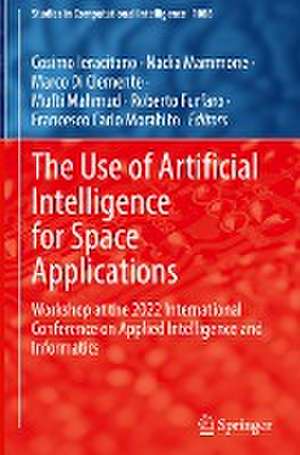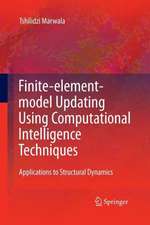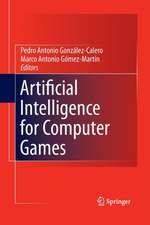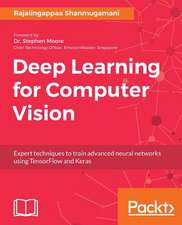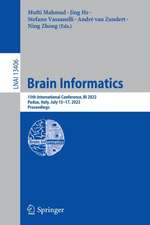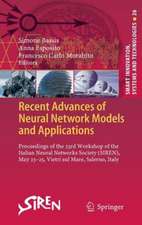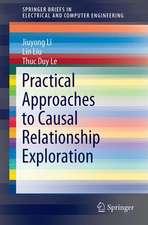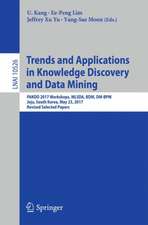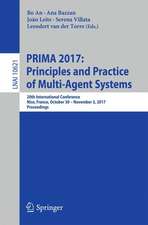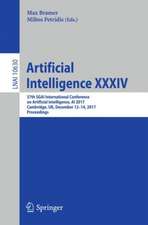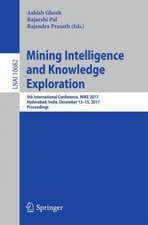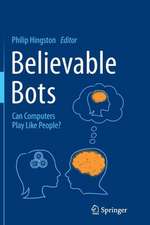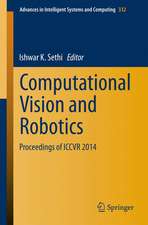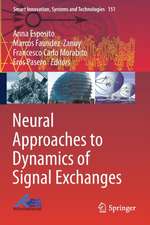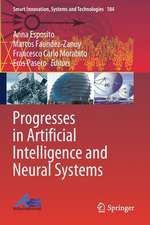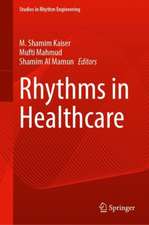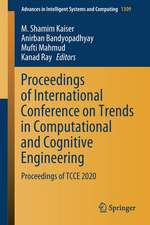The Use of Artificial Intelligence for Space Applications: Workshop at the 2022 International Conference on Applied Intelligence and Informatics: Studies in Computational Intelligence, cartea 1088
Editat de Cosimo Ieracitano, Nadia Mammone, Marco Di Clemente, Mufti Mahmud, Roberto Furfaro, Francesco Carlo Morabitoen Limba Engleză Hardback – 17 iun 2023
AI is not yet fully accepted as a pervasive technology in space applications because they are often mission-critical and the cost of space equipment and modules raises skepticism on any practical use and reliability. However, it is evident that its potential impact on many aspects is dramatic. Starting from either actual or experimental realizations, the book accompanies the reader through such fascinating subjects like space exploration, autonomous navigation and landing, rover control and guidance on rough surfaces, image analysis automation for planet or star classification, and for space debris avoidance without human intervention.
This kind of approach may facilitate further investigations on the same or similar subjects, as the future of space explorations is going toward adopting AI. The intended audience of the book are researchers from academia and space industries and practitioners in related start-ups.
| Toate formatele și edițiile | Preț | Express |
|---|---|---|
| Paperback (1) | 1285.92 lei 38-45 zile | |
| Springer Nature Switzerland – 18 iun 2024 | 1285.92 lei 38-45 zile | |
| Hardback (1) | 1460.19 lei 3-5 săpt. | |
| Springer Nature Switzerland – 17 iun 2023 | 1460.19 lei 3-5 săpt. |
Din seria Studies in Computational Intelligence
- 20%
 Preț: 449.37 lei
Preț: 449.37 lei - 20%
 Preț: 1158.26 lei
Preț: 1158.26 lei - 20%
 Preț: 986.66 lei
Preț: 986.66 lei - 20%
 Preț: 1452.76 lei
Preț: 1452.76 lei - 20%
 Preț: 168.78 lei
Preț: 168.78 lei - 18%
 Preț: 1112.30 lei
Preț: 1112.30 lei - 20%
 Preț: 565.38 lei
Preț: 565.38 lei - 20%
 Preț: 649.28 lei
Preț: 649.28 lei - 20%
 Preț: 1047.73 lei
Preț: 1047.73 lei - 20%
 Preț: 1578.96 lei
Preț: 1578.96 lei - 20%
 Preț: 643.50 lei
Preț: 643.50 lei - 20%
 Preț: 657.49 lei
Preț: 657.49 lei - 20%
 Preț: 993.28 lei
Preț: 993.28 lei - 20%
 Preț: 990.80 lei
Preț: 990.80 lei - 20%
 Preț: 989.96 lei
Preț: 989.96 lei - 20%
 Preț: 1165.69 lei
Preț: 1165.69 lei - 20%
 Preț: 1444.52 lei
Preț: 1444.52 lei - 20%
 Preț: 1041.96 lei
Preț: 1041.96 lei - 20%
 Preț: 1047.73 lei
Preț: 1047.73 lei - 20%
 Preț: 1046.06 lei
Preț: 1046.06 lei - 18%
 Preț: 2500.50 lei
Preț: 2500.50 lei - 20%
 Preț: 989.13 lei
Preț: 989.13 lei - 20%
 Preț: 1165.69 lei
Preț: 1165.69 lei - 20%
 Preț: 1164.05 lei
Preț: 1164.05 lei - 20%
 Preț: 1042.79 lei
Preț: 1042.79 lei - 18%
 Preț: 1403.52 lei
Preț: 1403.52 lei - 18%
 Preț: 1124.92 lei
Preț: 1124.92 lei - 20%
 Preț: 1039.47 lei
Preț: 1039.47 lei - 20%
 Preț: 1008.11 lei
Preț: 1008.11 lei - 20%
 Preț: 1045.25 lei
Preț: 1045.25 lei - 20%
 Preț: 1275.42 lei
Preț: 1275.42 lei - 20%
 Preț: 1040.32 lei
Preț: 1040.32 lei - 20%
 Preț: 988.32 lei
Preț: 988.32 lei - 20%
 Preț: 1169.79 lei
Preț: 1169.79 lei - 20%
 Preț: 1162.37 lei
Preț: 1162.37 lei - 20%
 Preț: 1059.26 lei
Preț: 1059.26 lei - 20%
 Preț: 1164.05 lei
Preț: 1164.05 lei - 20%
 Preț: 1166.52 lei
Preț: 1166.52 lei - 20%
 Preț: 1459.38 lei
Preț: 1459.38 lei - 18%
 Preț: 1005.74 lei
Preț: 1005.74 lei - 20%
 Preț: 997.38 lei
Preț: 997.38 lei - 20%
 Preț: 1055.94 lei
Preț: 1055.94 lei - 20%
 Preț: 1284.47 lei
Preț: 1284.47 lei - 20%
 Preț: 994.08 lei
Preț: 994.08 lei - 20%
 Preț: 1048.72 lei
Preț: 1048.72 lei - 20%
 Preț: 1066.02 lei
Preț: 1066.02 lei - 20%
 Preț: 943.78 lei
Preț: 943.78 lei - 20%
 Preț: 1173.10 lei
Preț: 1173.10 lei - 20%
 Preț: 1457.72 lei
Preț: 1457.72 lei
Preț: 1460.19 lei
Preț vechi: 1825.24 lei
-20% Nou
Puncte Express: 2190
Preț estimativ în valută:
279.40€ • 291.72$ • 231.24£
279.40€ • 291.72$ • 231.24£
Carte disponibilă
Livrare economică 14-28 martie
Preluare comenzi: 021 569.72.76
Specificații
ISBN-13: 9783031257544
ISBN-10: 3031257545
Pagini: 449
Ilustrații: XI, 449 p. 218 illus., 186 illus. in color.
Dimensiuni: 155 x 235 mm
Greutate: 0.91 kg
Ediția:2023
Editura: Springer Nature Switzerland
Colecția Springer
Seria Studies in Computational Intelligence
Locul publicării:Cham, Switzerland
ISBN-10: 3031257545
Pagini: 449
Ilustrații: XI, 449 p. 218 illus., 186 illus. in color.
Dimensiuni: 155 x 235 mm
Greutate: 0.91 kg
Ediția:2023
Editura: Springer Nature Switzerland
Colecția Springer
Seria Studies in Computational Intelligence
Locul publicării:Cham, Switzerland
Cuprins
SAR Image Formation: Conventional and AI-based approaches on Sentinel-1 Raw Products.- YOLO v4 Based Algorithm for Resident Space Object Detection and Tracking.- GPU@SAT: a general-purpose programmable accelerator for on board data processing and satellite autonomy.- Overview of Meta-Reinforcement Learning Methods for Autonomous Landing Guidance.- Satellite IoT for TT&C and Satellite Identification.- Hardware-in-the-loop simulations of future autonomous space systems aided by artificial intelligence.- Deep Reinforcement Learning for Pin-Point Autonomous Lunar Landing: Trajectory Recalculation for Obstacle Avoidance.- Imbalanced data handling for deep learning-based autonomous Crater Detection Algorithms in Terrain Relative Navigation.- Comparative Analysis of Reinforcement Learning Algorithms for Robust Interplanetary Trajectory Design.- Distribution Shift Metric for Performance Evaluation of Behavioral Cloning Applied to the Fuel-Optimal Landing Problem.- Fault Detection Exploiting Artificial Intelligence in Satellite Systems.- ISS Monocular Depth Estimation Via Deep Learning.- RobDT: AI-enhanced Digital Twins for Space Exploration Robotic Assets.- An Overview of X-TFC Applications for Aerospace Optimal Control Problems.- Innovative ML-based methods for automated on-board spacecraft anomaly detection.- Explainable AI with the Information Bottleneck Principle.- SINAV an ASI study of future AI applications on spatial rovers.- Deep Learning for Navigation of Small Satellites about Asteroids: an Introduction to the DeepNav Project.- Object recognition algorithms for the Didymos binary system.- Towards an explainable Artificial Intelligence approach for ships detection from satellite imagery.- Investigating Vision Transformers for Bridging Domain Gap in Satellite Pose Estimation.- Detection of Clouds and Cloud shadows on Sentinel-2 Data Using a CNN.- PRISMA Hyperspectral Image Segmentation with U-Net Convolutional Neural Network using Singular Value Decomposition for Mapping Mining Areas: preliminary results.- Earth Observation Big Data exploitation for water reservoirs continuous monitoring: the potential of Sentinel-2 data and HPC.- Retrieval of marine parameters from hyperspectral satellite data and machine learning methods.- Cooperative Lunar Site Preparation and Open Pit Resource Extraction Using Ground Robots.- Machine learning for SAR processing.- Canopy fire effects estimation using Sentinel-2 imagery and deep learning approach. A case study on the Aspromonte National Park.- A Supervised Learning-based Approach to Maneuver Detection Through TLE Data Mining.- A Machine learning approach for Monitoring of GNSS signal quality in Spaceborne receivers: Evil waveform and RF threats.
Notă biografică
Textul de pe ultima copertă
This book is an ideal and practical resource on the potential impact Artificial Intelligence (AI) can have in space sciences and applications. AI for Space Application presents a hands-on approach to browse in the subject and to learning how to do.
AI is not yet fully accepted as a pervasive technology in space applications because they are often mission-critical and the cost of space equipment and modules raises skepticism on any practical use and reliability. However, it is evident that its potential impact on many aspects is dramatic. Starting from either actual or experimental realizations, the book accompanies the reader through such fascinating subjects like space exploration, autonomous navigation and landing, rover control and guidance on rough surfaces, image analysis automation for planet or star classification, and for space debris avoidance without human intervention.
This kind of approach may facilitate further investigations on the same or similar subjects, as the future of space explorations is going toward adopting AI. The intended audience of the book are researchers from academia and space industries and practitioners in related start-ups.
AI is not yet fully accepted as a pervasive technology in space applications because they are often mission-critical and the cost of space equipment and modules raises skepticism on any practical use and reliability. However, it is evident that its potential impact on many aspects is dramatic. Starting from either actual or experimental realizations, the book accompanies the reader through such fascinating subjects like space exploration, autonomous navigation and landing, rover control and guidance on rough surfaces, image analysis automation for planet or star classification, and for space debris avoidance without human intervention.
This kind of approach may facilitate further investigations on the same or similar subjects, as the future of space explorations is going toward adopting AI. The intended audience of the book are researchers from academia and space industries and practitioners in related start-ups.
Caracteristici
Demonstrates the use of Artificial Intelligence for Space Applications Presents how AI-based systems are contributing to several space operations Examines the dialogue between AI and space and stimulates the exchange of ideas between researchers of these two fields
